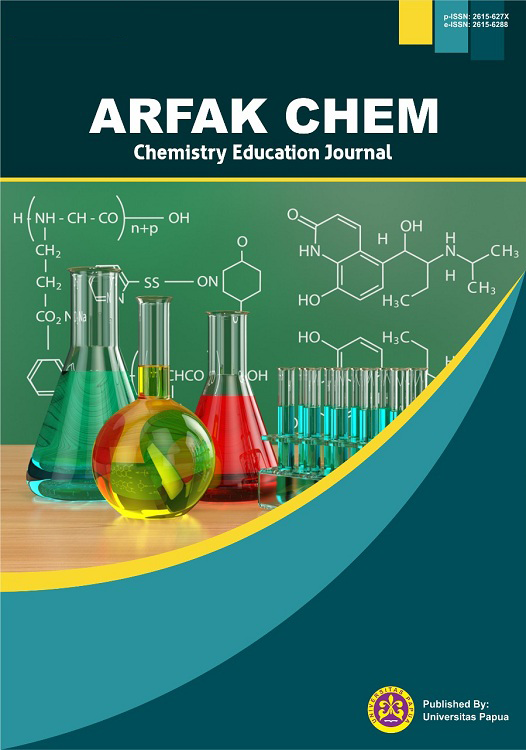PENERAPAN MODEL PEMBELAJARAN DISCOVERY LEARNING BERBANTUAN MEDIA PLASTISIN UNTUK MENINGKATAKAN MOTIVASI BELAJAR PESERTA DIDIK PADA MATERI BENTUK MOLEKUL KELAS X SMAN 1 SEKADAU
DOI:
https://doi.org/10.30862/accej.v3i2.306Abstract
Abstract
The purpose of classroom action research is to solve real problems that occur in the classroom and increase the real activities of teachers in their professional development activities. The classroom action research design used is the Kemmis model, which consists of 4 stages of research, namely planning, implementation, observation, and reflection. The results of data analysis showed that the teacher's activity in implementing discovery learning through animation media on chemical bonding material at SMAN 1 Sekadau increased with a percentage of 88.45% in the first cycle, 92.60% in the second cycle and 96.30% in the third cycle. Student activities in applying discovery learning through animation media on chemical bonding material at SMAN 1 Sekadau have a high percentage value in each activity. The learning outcomes of class X MIA-1 students at SMAN 1 Sekadau, experienced an increase in chemical bonding material after discovery learning was applied through animation media, namely cycle I with classical completeness in cycle I reaching 50%, cycle II 76%, and cycle III 93%. The value obtained is following the KKM standard on chemical bonding materials.
Â
Keywords: Classroom Action Research, Plasticine Media, Learning Motivation, Discovery
Downloads
Published
How to Cite
Issue
Section
License
License and Copyright Agreement
In submitting the manuscript to the journal, the authors certify that:
- They are authorized by their co-authors to enter into these arrangements.
- The work described has not been formally published before, except in the form of an abstract or as part of a published lecture, review, thesis, or overlay journal. Please also carefully read Arfak Chem: Chemistry Education Journal Posting Your Article Policy at http://journalfkipunipa.org/index.php/accej/about
- That it is not under consideration for publication elsewhere,
- That its publication has been approved by all the author(s) and by the responsible authorities – tacitly or explicitly – of the institutes where the work has been carried out.
- They secure the right to reproduce any material that has already been published or copyrighted elsewhere.
- They agree to the following license and copyright agreement.
Copyright
Authors who publish with Arfak Chem: Chemistry Education Journal agree to the following terms:
- Authors retain copyright and grant the journal right of first publication with the work simultaneously licensed under a Creative Commons Attribution License (CC BY-ND 4.0) that allows others to share the work with an acknowledgment of the work's authorship and initial publication in this journal.
- Authors are able to enter into separate, additional contractual arrangements for the non-exclusive distribution of the journal's published version of the work (e.g., post it to an institutional repository or publish it in a book), with an acknowledgment of its initial publication in this journal.
- Authors are permitted and encouraged to post their work online (e.g., in institutional repositories or on their website) prior to and during the submission process, as it can lead to productive exchanges, as well as earlier and greater citation of published work.









